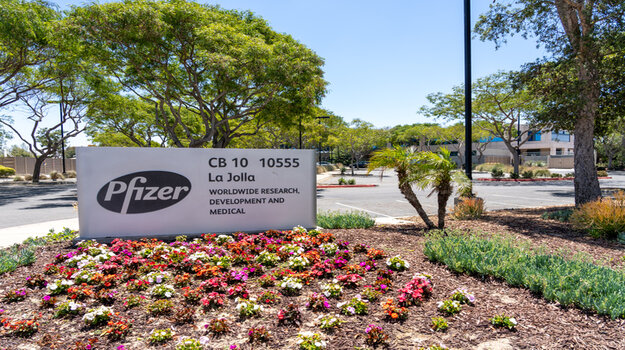Infection
Pfizer, Gilead, GSK to Capture Growing Infectious Diseases Market as J&J Pulls Back
Pictured: Pfizer’s sign at its La Jolla campus/iStock, JHVEPhoto
As the infectious diseases market expands, Pfizer, Gilead and GSK will climb to the top of the industry and emerge as the most dominant players in the space, according to data analytics and consultancy GlobalData.
In an industry analysis posted Wednesday, GlobalData projected that the infectious diseases market would grow 5.7% per year to reach $150 billion in annual sales by 2029. This growth is forecasted despite a nearly 64% plunge in COVID-19 sales in 2023, a largely vaccinated worldwide population and a recent WHO declaration about the end of the pandemic as a global health emergency.
The top industry player to seize this multibillion-dollar opportunity is Pfizer, which will sustain a 9.2% decline in annual sales forecast from 2023 to 2029 but will nevertheless hold the most dominant position in the infectious diseases space. This is due to its coronavirus assets Paxlovid (nirmatrelvir/ritonavir) and Comirnaty (COVID-19 Vaccine, mRNA), Kevin Marcaida, a GlobalData pharma analyst, said in a statement.
From 2023 to 2029, these two products will net Pfizer $122 billion in sales.
Behind Pfizer is Gilead, which does not have a robust coronavirus portfolio but instead will rely on its HIV product line, led by its blockbuster antiretroviral therapy Biktarvy (bictegravir/emtricitabine/tenofovir alafenamide). GlobalData expects this drug alone to make Gilead some $92 billion in revenue by 2029 and be a major contributor to the company’s projected 12.4% growth over the same timeframe.
Gilead has several other HIV treatments and prophylactics, including Complera (emtricitabine/rilpivirine/tenofovir disoproxil fumarate), Sunlenca (emtricitabine/tenofovir disoproxil fumarate) and Descovy (emtricitabine/tenofovir alafenamide).
GSK is also poised to reap the rewards of the $150 billion infectious diseases market with its shingles vaccine Shingrix (zoster vaccine recombinant, adjuvanted) and small-molecule HIV drug Dovato (dolutegravir/lamivudine), which GlobalData projects to generate approximately $41 billion and $20 billion in sales from 2023 to 2029, respectively.
Together, these three companies will account for some 62% of all infectious disease drug sales between 2023 and 2029 and will be chiefly responsible for driving growth in this space. “With their innovative products, these three industry leaders are well-positioned to capitalize on the expanding opportunities in the infectious diseases market,” Marcaida said.
Meanwhile, Johnson & Johnson is trailing far behind in the infectious diseases race. Placing eighth in GlobalData’s ranking, J&J is outpaced by fellow pharma heavy-hitters Merck, Moderna and AbbVie, as well as struggling vaccine developer Novavax, which only has one approved product.
During last week’s second-quarter earnings report, J&J announced it was slimming down its infectious diseases portfolio by seven programs, most of which were in hepatitis B, as reported by Endpoints News. Assets in hepatitis D, HIV and influenza were also being let go.
Going forward, the pharma will focus its infectious diseases efforts on only a handful of promising assets in HIV, COVID-19, Ebola and Escherichia coli leading to urinary tract infections and neonatal meningitis.
Tristan Manalac is an independent science writer based in metro Manila, Philippines. He can be reached at [email protected] or [email protected].

